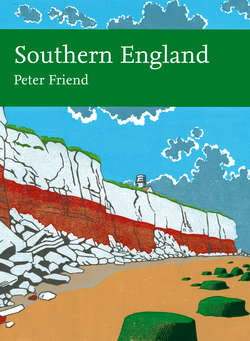Читать книгу Southern England - Peter Friend - Страница 18
DEVELOPMENT BY PEOPLE
ОглавлениеMy concern in this book is primarily with natural landscapes, and I will tend to comment on the development by people since the Bronze Age only where this relates to the natural features in an interesting way. However, in reviewing the appearance of the whole of Southern England, I have been struck by an intriguing distinction made by some landscape historians: the distinction between ancient and planned countryside (Figs 26–28). I have based my approach on the discussions offered by Oliver Rackham, ecologist and landscape historian, and these are summarised below.
Ancient countryside (Fig. 26) consists of many hamlets, small towns, ancient farms and hedges (of mixed varieties of shrubs and trees), along with roads that are not straight, numerous footpaths and many antiquities.
Planned countryside (Fig. 27) has distinct villages, much larger than the hamlets, along with larger eighteenth- and nineteenth-century farms, hedges of hawthorn and straight roads. Footpaths are less common and the few antiquities that are present are generally prehistoric.
I have re-examined the same areas used by Oliver Rackham as examples of these two countryside types, and compared the early Ordnance Survey maps with maps of the same area generated by me using the data and methods used in this book (see Chapter 1). The shading and ‘hachured’ patterning used in the earlier maps represents the hills and slopes rather clearly – better than the contour representation used in the present-day Ordnance Survey Landranger maps, although these show man-made features much more clearly. My map representation is a compromise in that it represents elevations and slopes using colours and hill-shading, but also allows the patterns of roads and settlements to be seen.
Oliver Rackham’s conclusion is that many of the distinctive features of planned countryside were created by the general parliamentary enclosure of land during the eighteenth and nineteenth centuries. This involved the wholesale conversion of commonly held land with open fields into enclosed fields awarded to individuals and institutions. Many landscape historians have claimed earlier origins for the difference between ancient and planned countryside, believing that historical and cultural differences in the people who settled and developed the two areas played an important role. Variations in the bedrock geology also seem to be important here. For example, the ancient countryside shown in Figure 26 is underlain by strongly deformed Variscan bedrock that has been eroded into small hills and valleys (see Chapter 4).
FIG 26. Example of ancient countryside at the Devon-Somerset border, near Tiverton, with 1809 and recent mapping compared. (Upper part from Cassini Old Series map 181, copyright Cassini Publishing 2007/www.cassinimaps.co.uk)
FIG 27. Example of planned countryside at the Berkshire-Oxfordshire border, around Didcot, with 1830s and recent mapping compared. (Upper part taken from Cassini Old Series maps 164 and 174, copyright Cassini Publishing 2007/www.cassinimaps.co.uk)
FIG 28. Generalised map distinguishing ancient and planned countryside across Southern England.
In contrast, the planned countryside covered by Figure 27 consists of only gently tilted Mesozoic bedrock that has formed a much flatter and more open landscape.
